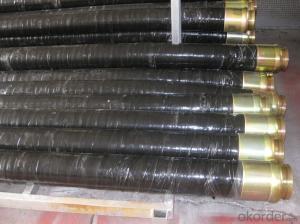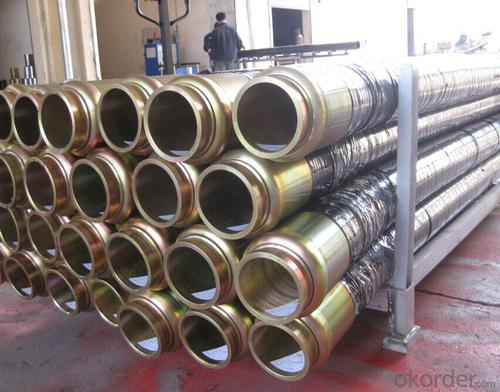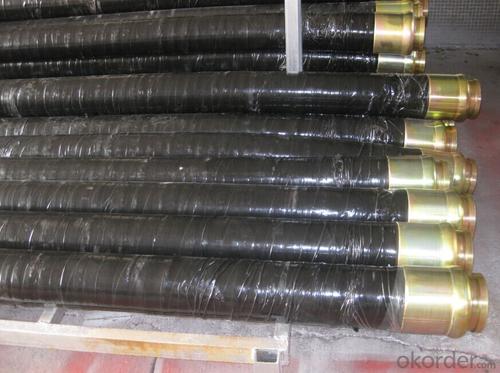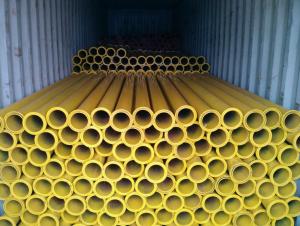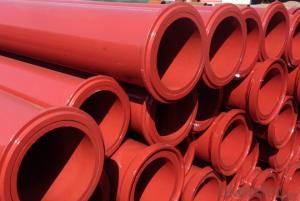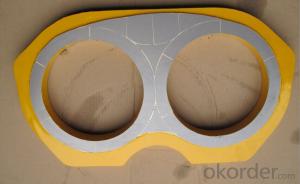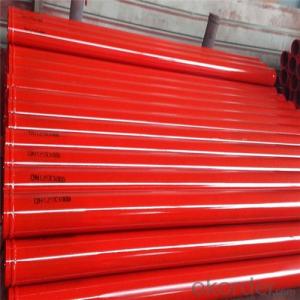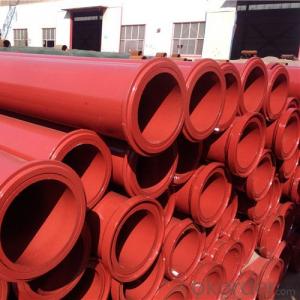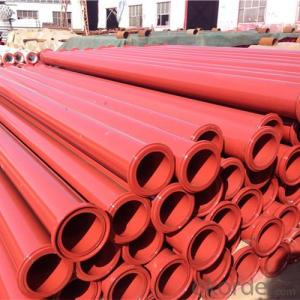5M*DN80 RUBBER END HOSE WITH TWO SIDE COUPLINGS WORKING PRESSURE 85 BAR
- Loading Port:
- Shanghai
- Payment Terms:
- TT OR LC
- Min Order Qty:
- 10 pc
- Supply Capability:
- 5000 pc/month
OKorder Service Pledge
OKorder Financial Service
You Might Also Like
Specifications
Putzmeister concrete pump end rubber hose
1. Size: DN150, DN125, DN100, DN80...
2. Length: 1~9m
Concrete pump end rubber hose PM &Schwing
Name | Specifications | Application | Flange diameter | Remarks |
Rubber hose | DN125*3000 | Concrete pump | 148/DN157mm | |
Rubber hose | DN150*3000 | Concrete pump | 148/DN157mm | |
High pressure | DN125*3000 | Concrete pump | 148/DN157mm | Two layers of steel wire |
High pressure | DN125*3000 | Concrete pump | 148/DN157mm | Four layers of steel wire |
High pressure | DN125*4000 | Concrete pump | 148/DN157mm | |
High pressure | DN150*3000 | Concrete pump | 175mm | |
| DN80*5000 | Mortar pump mini conctete pump | 98mm | |
| DN80*6000 | Mortar pump mini conctete pump | 98mm | |
| DN100*5000 | Mortar pump mini conctete pump | 124mm | |
| DN76*6000 | Fine stone concrete pump mini conctete pump |
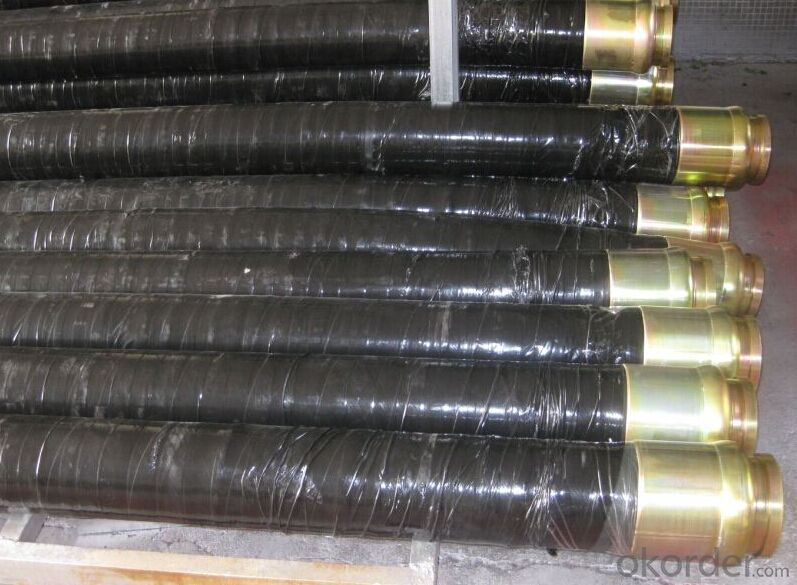
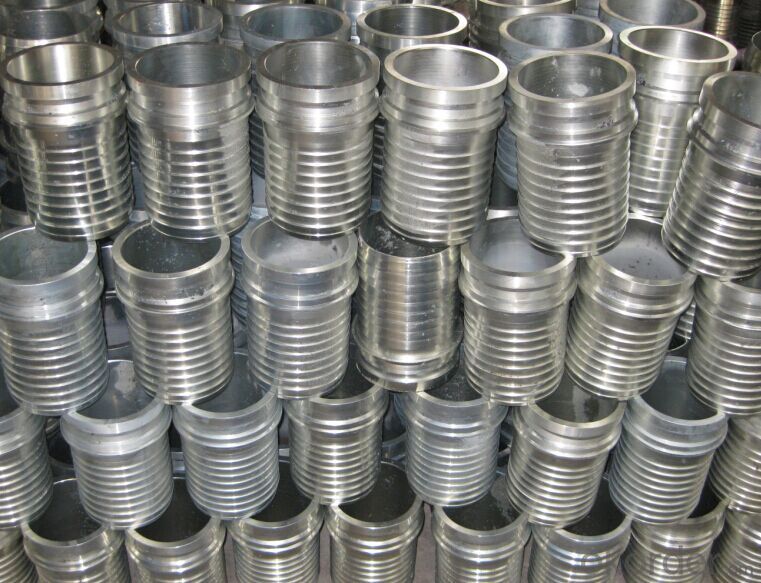
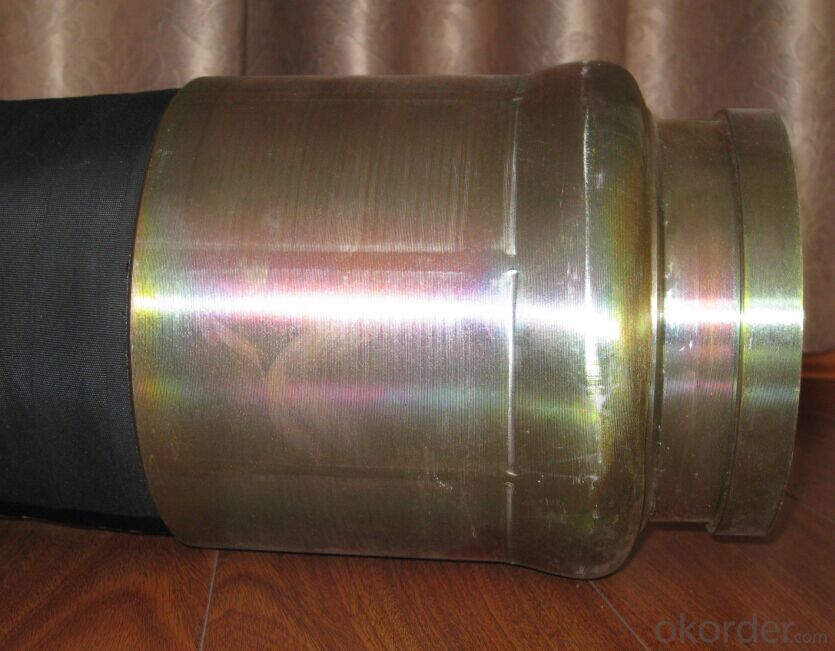
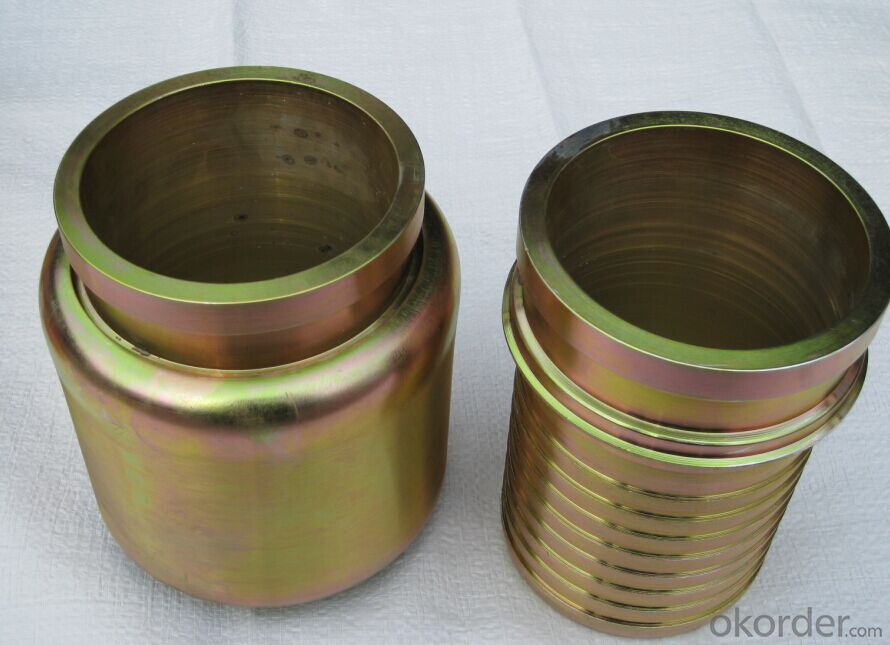
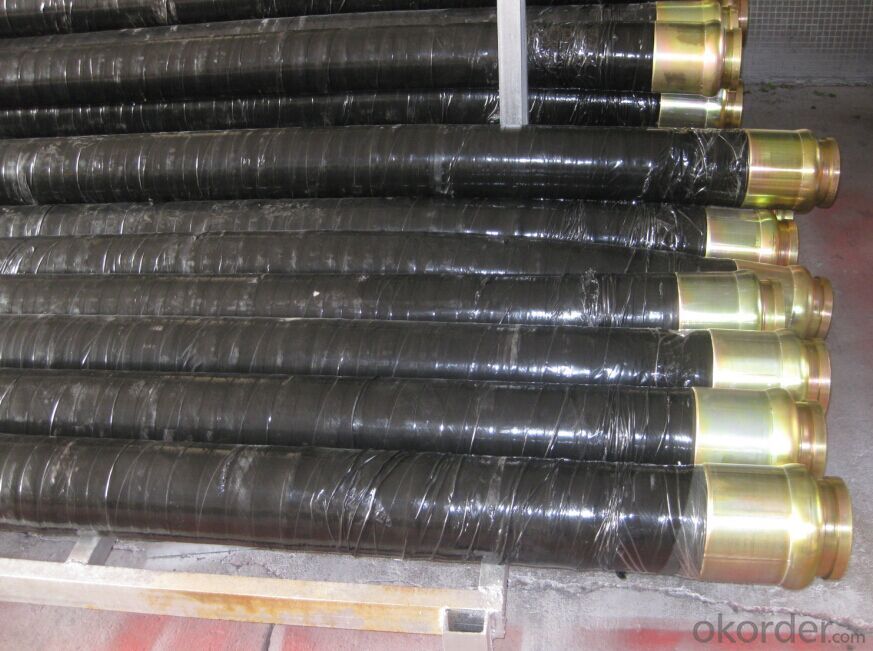
- Q: What are the signs of a damaged concrete pump S valve?
- There are several signs that indicate a damaged concrete pump S valve. 1. Leakage: One of the most common signs of a damaged S valve is leakage. If you notice any fluid or concrete leaking from the S valve, it could be an indication of a damaged or worn-out seal or gasket. 2. Reduced pumping efficiency: A damaged S valve can lead to reduced pumping efficiency. You may notice that the concrete flow is not as smooth or continuous as before, and it may take longer to pump the same amount of concrete. 3. Increased pressure: When the S valve is damaged, it can result in increased pressure within the pump system. This can cause strain on other components of the pump and lead to further damage or malfunction. 4. Unusual noises: Another sign of a damaged S valve is the presence of unusual noises during pumping operations. You may hear grinding, squeaking, or other abnormal sounds that indicate a problem with the S valve mechanism. 5. Difficulty in switching directions: The S valve is responsible for controlling the flow direction of the concrete. If you experience difficulty or resistance when switching the direction of the concrete flow, it could be a sign of a damaged S valve. 6. Inconsistent concrete flow: A damaged S valve can cause inconsistent concrete flow, resulting in uneven distribution or blockages in the delivery line. This can lead to delays and inefficiencies in the construction process. It is important to address any signs of a damaged S valve promptly to prevent further damage and ensure the safe and efficient operation of the concrete pump. Consulting a professional or the manufacturer's guidelines is recommended for proper diagnosis and repair of the S valve.
- Q: Are there any cost-effective alternatives to original concrete pump spare parts?
- Yes, there are cost-effective alternatives to original concrete pump spare parts. One option is to consider purchasing aftermarket parts, which are often produced by third-party manufacturers. These parts are designed to meet the same specifications and standards as the original parts but are typically available at a lower price. Another option is to explore the option of purchasing used or refurbished parts. These parts have been previously used but have been restored to a good working condition, offering a more affordable alternative to new parts. However, it is important to ensure that these alternatives are sourced from reputable suppliers to ensure quality and compatibility with your specific concrete pump model.
- Q: Are there any specific guidelines for the installation of wear plates or cutting rings in concrete pump spare parts?
- Yes, there are specific guidelines for the installation of wear plates and cutting rings in concrete pump spare parts. These guidelines are important to ensure the proper functioning and longevity of the pump. 1. Firstly, it is important to clean the surface where the wear plate and cutting ring will be installed. Any debris, dust, or old material should be removed to ensure a smooth and secure fit. 2. The wear plate and cutting ring should be inspected for any damage or defects before installation. Any parts that are worn out or damaged should be replaced to avoid any potential issues during operation. 3. Apply a thin layer of lubricant or grease to the surface where the wear plate and cutting ring will be installed. This will help with the alignment and ease of installation. 4. Carefully align the wear plate and cutting ring with the designated slots or grooves in the concrete pump. It is crucial to ensure that they are accurately positioned to avoid misalignment or premature wear. 5. Use appropriate tools or equipment to secure the wear plate and cutting ring in place. This may involve tightening bolts, screws, or other fasteners. It is important to follow the manufacturer's instructions and torque specifications to ensure proper installation. 6. After installation, perform a visual inspection to ensure that the wear plate and cutting ring are securely in place and properly aligned. Any signs of misalignment or loose parts should be addressed immediately. 7. Regular maintenance and inspection of the wear plates and cutting rings are essential to identify any signs of wear or damage. It is recommended to follow the manufacturer's recommendations for maintenance intervals and replacement schedules. By following these specific guidelines, you can ensure the proper installation and function of wear plates and cutting rings in concrete pump spare parts, leading to improved performance and extended lifespan of the equipment.
- Q: What is the purpose of a concrete pump hydraulic accumulator bladder?
- The purpose of a concrete pump hydraulic accumulator bladder is to store and release hydraulic energy within a concrete pump system. The bladder acts as a flexible barrier between the hydraulic fluid and a gas or air chamber. When hydraulic fluid is pumped into the bladder, it compresses the gas or air inside, storing potential energy. This energy can then be released when needed to power the hydraulic system, providing a surge of pressure and flow to ensure efficient and controlled movement of the concrete. The hydraulic accumulator bladder serves several important functions in a concrete pump system. Firstly, it helps to smooth out and regulate the flow of hydraulic fluid, reducing pressure fluctuations and ensuring a steady and consistent supply of power to the pump. This helps to prevent damage to the pump components and ensures a more reliable and efficient operation. Additionally, the bladder helps to compensate for variations in demand. As the concrete pump operates, there may be times when the demand for hydraulic power exceeds the supply. In such cases, the bladder can release the stored energy to meet the increased demand, providing a temporary boost to the hydraulic system. This helps to maintain a consistent and continuous flow of concrete, even during peak demand periods. Furthermore, the hydraulic accumulator bladder can also act as a safety device. In the event of a sudden pressure surge or spike in the hydraulic system, the bladder can absorb and dampen the excess pressure, preventing damage to the pump or other components. This helps to protect the equipment and ensure the safety of the operators. In summary, the purpose of a concrete pump hydraulic accumulator bladder is to store and release hydraulic energy, smooth out and regulate hydraulic fluid flow, compensate for variations in demand, and act as a safety device. By performing these functions, the bladder helps to optimize the performance and efficiency of the concrete pump system, ensuring a reliable and controlled movement of concrete.
- Q: How do I properly maintain and replace filters in concrete pump spare parts?
- To ensure optimal performance and longevity of your equipment, it is crucial to properly maintain and replace filters in concrete pump spare parts. Here are some guidelines to follow: 1. Get familiar with the different types of filters: Concrete pumps have various filters for hydraulic oil, fuel, air, and water. Take the time to understand which filters are used in your equipment. 2. Consult the manufacturer's instructions: Read the equipment manual and adhere to the guidelines provided by the manufacturer regarding filter maintenance and replacement intervals. This will ensure that you are following the recommended practices. 3. Conduct regular filter inspections: Periodically check the filters for signs of damage, clogging, or excessive debris accumulation. You can visually inspect them or measure the pressure differential across the filter. If the pressure differential exceeds the recommended limit, it may be necessary to replace the filter. 4. Clean or replace filters as required: If the filters are clogged or dirty, they should be cleaned or replaced. Some filters can be cleaned by blowing compressed air in the opposite direction of the airflow to remove debris. However, it is important to note that certain filters are disposable and cannot be cleaned. 5. Use authentic spare parts: When replacing filters, always opt for genuine spare parts recommended by the manufacturer. This ensures compatibility and performance. 6. Follow proper handling and installation procedures: When installing new filters, make sure to handle them with clean hands or wear gloves to prevent contamination. Follow the correct installation procedure, such as tightening the filter housing to the recommended torque value. 7. Maintain a regular maintenance schedule: Establish a consistent schedule for filter inspection, cleaning, and replacement. This will help you stay on top of filter maintenance and prevent potential issues caused by dirty or clogged filters. By adhering to these steps, you can effectively maintain and replace filters in concrete pump spare parts, ensuring efficient equipment operation and an extended lifespan.
- Q: Is the main pump of the concrete pump electric control or hydraulic control?
- The main pump behind the oil pump to provide the size of the oil with the greater the current the higher the higher the higher the displacement,
- Q: Can I get spare parts for both concrete pumps with and without lubrication systems?
- Spare parts are available for both lubricated and non-lubricated concrete pumps. Various manufacturers and suppliers offer a diverse selection of spare parts for different concrete pump types and models. These spare parts encompass valves, cylinders, pistons, seals, hoses, filters, and more. Regardless of whether your concrete pump is equipped with a lubrication system or not, you can easily locate the required spare parts for its maintenance and repair. It is advisable to consult the manufacturer or a reliable supplier to ensure the procurement of accurate spare parts that match your specific concrete pump model.
- Q: Can concrete pump spare parts be tested for performance and quality before installation?
- It is imperative to test concrete pump spare parts for performance and quality before installation. This ensures that they conform to necessary standards and specifications, and aids in detecting any flaws or concerns that might impact their performance or longevity. Testing can be carried out through diverse methods, including physical inspections, functional assessments, or deploying specialized equipment to gauge specific parameters. By conducting pre-installation tests on these spare parts, potential issues can be identified and rectified at an early stage, thereby guaranteeing peak performance and quality.
- Q: How do I maintain the performance of concrete pump spare parts in extreme weather conditions?
- To ensure the efficiency and longevity of your equipment, it is crucial to maintain the performance of concrete pump spare parts in extreme weather conditions. Consider the following tips: 1. Conduct regular inspections to detect signs of wear and tear early on. Extreme weather can accelerate part deterioration, so staying vigilant is important. 2. Keep spare parts clean to prevent clogging or damage caused by dirt, debris, or contaminants that may accumulate in extreme weather conditions. 3. Use appropriate lubrication for smooth functioning. Opt for lubricants designed for extreme weather, with high viscosity and resistance to temperature fluctuations. 4. Protect spare parts from direct exposure to extreme heat or freezing temperatures by using covers or enclosures. 5. Store spare parts in a dry, temperature-controlled environment when not in use. Extreme weather can cause expansion or contraction, potentially leading to damage. Controlled storage helps maintain integrity and performance. 6. Monitor and replace worn-out parts in a timely manner to maintain performance. Extreme weather conditions can accelerate wear and tear, so proactive replacement is crucial. 7. Consult the manufacturer for specific requirements on maintaining spare parts in extreme weather. They can offer expert advice and guidance for optimal performance. By following these tips, you can effectively preserve the performance of concrete pump spare parts in extreme weather conditions, ensuring smooth and efficient equipment operation.
- Q: Can concrete pump spare parts be coated with corrosion inhibitors for long-term storage?
- Concrete pump spare parts have the capability to be coated with corrosion inhibitors in order to ensure long-term storage. Corrosion inhibitors, which are chemicals, can be applied onto metal surfaces to either prevent or minimize the corrosion process. By administering a coating of corrosion inhibitor onto concrete pump spare parts, a protective layer can be formed, preventing any contact between moisture, oxygen, and the metal. Consequently, the chances of corrosion are significantly reduced. This becomes particularly crucial when considering long-term storage, as the spare parts might encounter harsh environmental conditions or be stored in damp areas. Ultimately, the corrosion inhibitor coating serves to extend the lifespan of the spare parts and guarantee their preservation until they are required for use.
Send your message to us
5M*DN80 RUBBER END HOSE WITH TWO SIDE COUPLINGS WORKING PRESSURE 85 BAR
- Loading Port:
- Shanghai
- Payment Terms:
- TT OR LC
- Min Order Qty:
- 10 pc
- Supply Capability:
- 5000 pc/month
OKorder Service Pledge
OKorder Financial Service
Similar products
Hot products
Hot Searches
Related keywords

